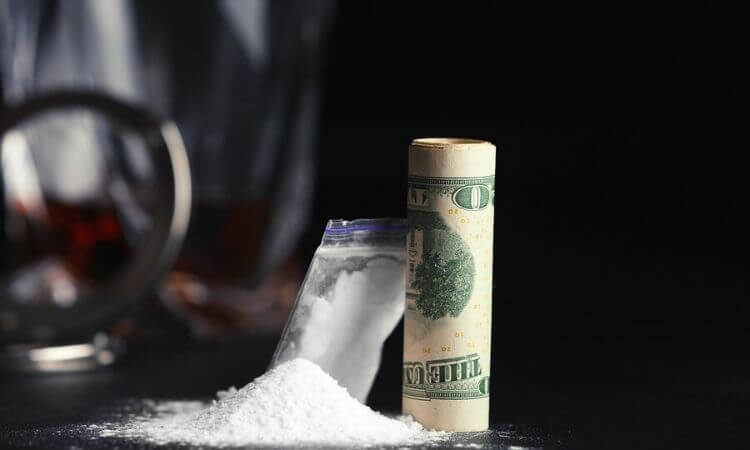
When a person uses cocaine, they will almost instantly experience euphoria, increased feelings of energy, and sometimes even hyperactivity. The effects of cocaine are brief, however, and usually only last about 20 minutes on average. When effects wear off, the person may feel depressed, irritable, fatigued, and generally unwell. This article details the most effective and comfortable way on how to come down from coke use.
What Is Cocaine?
If you’ve come here seeking answers for yourself, you probably don’t need to read long explanations about what cocaine is. If you are here for a loved one, there are a few facts you may need to know.
Cocaine is a stimulant drug derived from the coca plant native to South America. It has a high potential for abuse, dependence, and addiction.
It is typically sold on the street in the form of a white powder or as “crack,” which are small rock-shaped pieces. Crack is usually smoked, and powder cocaine powder is most often snorted intranasally.
Crack is more intense and more rapid-acting than cocaine. However, both side effects and withdrawal symptoms remain nearly identical except for factors that are caused by the method of administration (i.e., smoking, snorting, or injecting).
Effects of Cocaine
Cocaine’s desired effects are produced because the drug interrupts the reabsorption of dopamine, a neurotransmitter in the brain responsible for feelings of pleasure, reward, and well-being. By blocking these receptors, the brain is inundated with feel-good chemicals that quickly produce a brief but intense euphoric high. After multiple uses, the person can become chemically and psychologically addicted to cocaine.
Also, tolerance to cocaine can develop rapidly, a condition that requires the users to administer increasing amounts of the drug to achieve the desired effect. Dependence, another aspect of addiction, occurs as the user’s brain gradually becomes accustomed to the presence of cocaine. Eventually, the person will become unable to function normally without it. This condition results in unpleasant withdrawal symptoms when the person tries to quit or cut back.
When a high subsides, a “crash” or “comedown” occurs that is characterized by mental and physical fatigue and often depression. These feelings commonly lead to more cocaine use to avoid them. Although not life-threatening, the crash and withdrawal period increase the risk of relapse or suicide.
How to Come Down From Coke Use: Assessment

Addiction is a chronic brain disease that is, fortunately, very treatable using a comprehensive treatment approach. Many patients begin their recovery by undergoing a medical detox, a process in which cocaine and other substances are purged from the system in a safe, supervised, and controlled environment. This process can be conducted by medical professionals and addiction specialists at a specialized detox facility or treatment center.
A comprehensive medical and mental health assessment is essential to determine the best detox and recovery plan for issues related to cocaine abuse or addiction. The process begins with a complete physical, mental, and social evaluation administered by a medical or addiction professional, who will ultimately order the appropriate testing and determine the best course of treatment. A full medical history is required to identify underlying medical or mental health conditions as well as gather information about family history related to these issues.
Co-Occurring Mental Illness
Mental illness and cocaine abuse frequently co-occur, and an estimated 84% of cocaine in the U.S. is used by those who have experienced some type of mental illness within their lifetime. Also, it was found that having a mental health condition increased the likelihood of using cocaine by 27%. Furthermore, a history of mental illness increases the potential cocaine use by 69% over the general population.
For those with a mental health disorder, substance abuse is often a means of self-medication in an attempt to provide temporary relief. Unfortunately, substance use can and often does make mental illness worse, exacerbating symptoms, and conflicting with mental health treatment.
The Restoration of Physical Balance
The primary goal of detox is physical restabilization. Stimulant drugs increase heart rate, energy, blood pressure, body temperature. They also can suppress appetite and decrease the need for sleep. Cocaine abuse can be particularly damaging to the heart, and also alters chemical functioning in the brain that often takes time to reverse.
During and following a chemical detox, the body will need to stabilize physically. For example, cocaine use can reduce a person’s appetite and result in dramatic weight loss. For this reason, some people in recovery may need to follow a diet plan that can help restore them to a healthy body weight.
Physical exercise is a boon during detox, as it releases some of the same natural feel-good chemicals as cocaine and increases strength and stamina. Yoga and meditation have been clinically shown to help reduce stress and increase energy and focus, as well.
Cocaine Withdrawal

Cocaine has a short half-life, which is the time it takes for the drug’s presence in the blood and urine to be reduced by half. It is estimated that cocaine’s half-life in the blood is about 1.5 hours, and once this occurs, users may begin to experience withdrawal symptoms.
The duration and severity of withdrawal symptoms are dependent on a variety of factors, including the following:
- Amount of the drug that was regularly used
- The physical form of the drug and its potency (e.g., crack vs. powdered cocaine)
- Method of administration (e.g., snorting vs. smoking)
- Duration of abuse
- Level of physical dependency
- Individual physiological factors (e.g., metabolism rate)
- Concurrent abuse of other drugs or alcohol
Cocaine withdrawal typically occurs in three phases: the crash, withdrawal period, and extinction. During the crash phase, users often require more sleep than usual and also experience an increased appetite. They may also encounter fatigue, irritability, depression, anxiety, and dysphoria during this initial period. For this reason, offering healthy meal options and routine sleep schedules can help to regulate the body.
The middle phase consists of drug cravings, difficulty concentrating, and sometimes prolonged feelings of irritability, depression, and lethargy. Relapse prevention methods and psychotherapy are critical during this phase. Extinction is the last phase, and occasional drug cravings can be managed through therapy, counseling, and support groups.
The Use of Medications
At the time of this writing, there are currently no medications approved for the treatment of cocaine addiction. However, several medications to help with emotional issues may be beneficial during detox, such as antidepressants and other mood stabilizers.
Getting Treatment for Cocaine Addiction
Many people who come down from coke use are not regular users and do not necessarily in need of treatment. However, people who use cocaine regularly (e.g., every day) probably have a substance use disorder and should seek professional treatment.
For those who experience co-occurring disorders such as substance abuse and a mental health condition, such as depression, a dual diagnosis treatment plan offers the highest rate of success. Programs, such as those offered by Harmony Recovery Center, use an integrated approach that treats both disorders simultaneously. In doing so, we address all aspects of a person’s well-being to ensure they have the best chance of sustaining long-term abstinence and good mental health.
You can regain your life and enjoy the happiness and wellness you deserve! Please call us as soon as possible to find out how we can help!